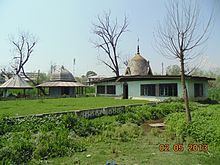 | ||
Located on the suburbs of Srinagar, Vichar Nag is a locality that gets its name form an ancient and historically important Shiva Temple. Famous Anchar Lake is close to this monumental pride of ancient Kashmir. Vichar Nag finds it mention at many places in the history of Kashmir including the famous 'Rajtaragni' by Kalhan.
Contents
- Map of Vicharnag Srinagar 190011
- Vichar Nag Temple
- Religious Historical Importance
- Current Situation
- References
Map of Vicharnag, Srinagar 190011
Vichar Nag Temple
Vichar Nag is famous for its spring and two old Shiva temples. One temple is made of chisled and dressed devri stones. There are two springs with the main big spring as the centre of attraction and sanctity. The spring has a length of 430 feet and breadth of 35 feet. Big sized ‘Devri’ stones have been used for construction of stairs to the spring on West and South side. There is no access on north and east side probably to face the morning glory of the Sun.
In the middle of the spring, there is a stone cylinder of about 3 feet height with a Shivalingam resting on it. Before the exodus of Kashmir Pandits in 1990 by the Islamic fanatics, the water from the spring used to come out in the shape of a small brook, joining the other brook called ‘Mukhta Pukhri'. After covering a sizeable distance the water used to flow into Lake Anchar.
1990's saw the exodus of almost all the Hindus of Vicharnag and the temple maintenance suffered badly. With lack of interest either in the history of Kashmir or an ancient temple, the local Muslim population let it fall into a state of disrepair.
Till early 90's from the time immemorial, the spring water contained many fishes. The other unique feature of the spring is that water turns ice cold in summer and lukewarm in winter.
In the vicinity of Vichar Nag, there were many springs earlier, which have been lost over the time, largely due to encroachments and non-care by the local population.
Religious & Historical Importance
Vichar Nag was seat of discussion (hence the name, Vichar)and it was in this temple that Kashmiri Brahmins used to discuss Panchang. It is said His Holiness Jagat Guru Shankaracharya also visited this temple for discussion.
Kashmir has been always a seat of learning and it is believed that The 2nd Fourth Buddhist Council (Sarvastivada tradition) is said to have been convened by the Kushan emperor Kanishka (r. 127-151 CE), perhaps in 78 CE at Vichar Nag in Kashmir.
Before 1990, on Chaitra Amavasiya, the last day of Kashmiri calendar, a festival was celebrated at this place. On this day, devotees used to take a bath in the holy spring and there after performed puja in the Shiva Temple known as ‘Vichar Saheb’.
Current Situation
Due the forced exodus of Kashmiri Pandits by the Pakistan sponsored Islamic Jihadis, the temple maintenance suffered. The temple turned into ruins and miscreants desecrated the idols and damaged excellent murals, which were few centuries old.
The centuries old Shivling had to be secretly taken away to avoid any damage to it. The springs were used as garbage dumping ground and were almost invisible in the wild vegetation that had grown in the temple complex.
Recent efforts of some individuals has resulted in the springs being cleaned and temples and two of its many dharamshalas being restored. But to preserve this heritage, government involvement is necessary. The local politicians and bureaucrats have the rise above the religion to save legacy and heritage of Kashmir
